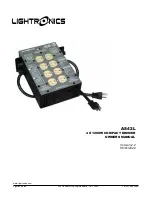
6
ENGLISH
appliance, replace or repair any damaged parts, check
for and tighten any loose parts.
• Avoid using the machine in bad weather conditions
especially when there is a risk of lightning.
• Use in a dry location only.
• Do not allow the machine to become wet.
• Do not immerse the machine in water.
• Do not open the body casing. There are not userserviceable
parts inside.
• Do not operate the machine in explosive atmospheres,
such as in the presence of flammable liquids, gases or dust.
• To reduce the risk of damage to plugs or cords, never
pull the cable to remove the plug from a socket.
Safety of Others
• Never allow children, persons with reduced physical,
sensory or mental capabilities or lack of experience and
knowledge or people unfamiliar with these instructions
to use the machine, local regulations may restrict the
age of the operator.
• Children shall not play with the machine.
• Cleaning and user maintenance shall not be made by
children without supervision.
Residual Risks
Additional residual risks may arise when using the tool
which may not be included in the enclosed safety warnings.
These risks can arise from misuse, prolonged use etc.
Even with the application of the relevant safety regulations
and the implementation of safety devices, certain residual
risks can not be avoided. These include:
• Injuries caused by touching any rotating/moving parts.
• Injuries caused when changing any parts, blades or
accessories.
• Injuries caused by prolonged use of a tool. When using any
tool for prolonged periods ensure you take regular breaks.
• Impairment of hearing.
• Health hazards caused by breathing dust developed
when using your tool (example:- working with wood,
especially oak, beech and MDF).
After Use
• When not in use, the machine should be stored in a dry,
well ventilated place out of reach of children.
• Children should not have access to stored machines.
• When the machine is stored or transported in a vehicle
it should be placed in the boot or restrained to prevent
movement following sudden changes in speed or
direction.
Inspection and Repairs
• Before use, check the machine for damaged or defective
parts. Check for breakage of parts and any other
conditions that may affect its operation.
• Do not use the machine if any part is damaged or
defective.
• Have any damaged or defective parts repaired or
replaced by an authorised repair agent.
• Never attempt to remove or replace any parts other
than those specified in this manual.
Extension Cords
Make sure your extension cord is in good condition. When
using an extension cord, be sure to use one heavy enough
to carry the current your product will draw. An undersized
cord will cause a drop in line voltage resulting in loss of power
and overheating. The following table shows the correct size to
use depending on cord length and nameplate ampere rating.
If in doubt, use the next heavier gage. The smaller the gage
number, the heavier the cord.
Minimum gage for cord sets
Volts
Total length of cord in feet (ft)
120 V - 127V
0 - 25
26 - 50
51 - 100
101 - 150
220 V
0 - 50
51 - 100
101 - 200 201 - 300
Ampers
Wire gauge in square millimeters
(mm
2
)
More
than
No more
than
0
6
1,0
1,5
1,5
2,5
6
10
1,0
1,5
2,5
4,0
10
12
1,5
1,5
2,5
4,0
12
16
2,5
4,0
Not recommended
ADDITIONAL SAFETY INSTRUCTIONS FOR
STRING TRIMMERS
WARNING:
Cutting elements continue to rotate after
the motor is switched off.
• Be familiar with the controls and the proper use of the
appliance.
• Before use, check the power supply cord and extension
cord for signs of damage, ageing and wear. If a cord
becomes damaged during use, disconnect the cord
from the mains supply immediately. DO NOT TOUCH
THE CORD BEFORE DISCONNECTING THE SUPPLY.
• Do not use the appliance if the cords are damaged or worn.
• Before using the appliance and after any impact, check
for signs of wear or damage and repair as necessary.
• Always ensure that the ventilation slots are kept clear of debris.
• Wear stout shoes or boots to protect your feet.
• Wear long trousers to protect your legs.
• Before using the appliance, check that your cutting path
is free from sticks, stones, wire and any other obstacles.
• Only use the appliance in the upright position, with
the cutting line near the ground. Never switch the
appliance on in any other position.
• Be cautious and keep your balance at all times. Stay
firmly on the slopes at all times and never run.
• Do not work on steep slopes. Work across the face of
slopes, not up and down.
• Move slowly when using the appliance. Be aware that
freshly cut grass is damp and slippery.
• Never cross gravel paths or roads while the appliance
is running.
• Before using the appliance and after any impact, check
for signs of wear or damage and repair as necessary.







































